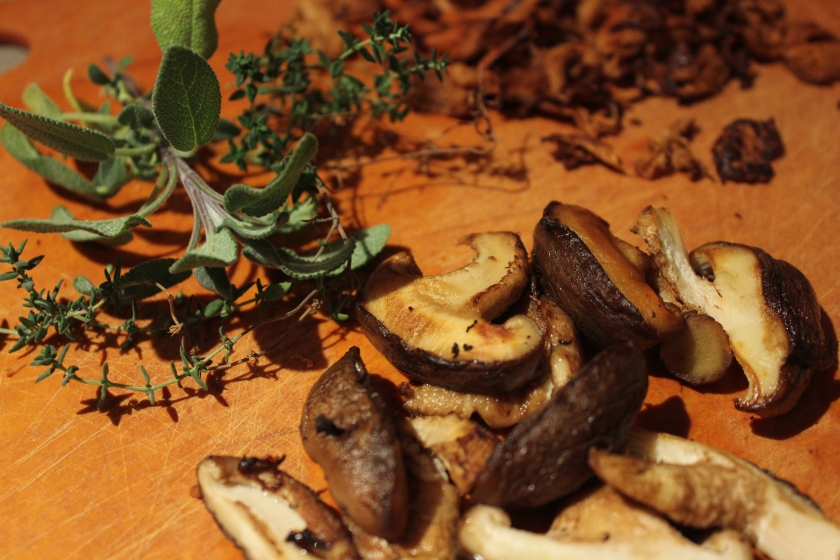Risotto is epic. Think of it as a canvass to unleash your culinary creativity, since it is the perfect vehicle to carry an inspiring flavour to the plate! Follow the formulaic process for creating the risotto base, and then finish it with literally countless variations of accenting flavours. The basic recipe for risotto is astoundingly simple, and the key to a perfect risotto is all in the technique:
Saute onions with olive oil, then add rice and continue. Add hot stock, one ladle at a time while stirring the risotto to massage out the starch from the grains. Finish with butter and parmesan.
The perfect risotto should have an individual bite to each grain, not an overcooked rice-pudding like texture. It should also be freely flowing, and not overly stiff. This is one of the most common crimes against risotto. Let me say this, if your risotto sticks to the underside of an upside down spoon, it is too stiff! A proper risotto will slowly ooze, like a slow flow of lava!
Mushroom risotto is a classic dish for the fall. Mushroom stock can be created by soaking dried mushrooms, with porcini carrying the most prominent umami flavour for the base. The re-constituted mushrooms can then be added back into the risotto for flavour and texture. I like to finish the risotto with an assortment of whatever fresh mushrooms I can get my hands on, sautéed to bring out their earthy flavour.
Ingredients:
1 cup Arborio or Carnaroli rice
2 cups chicken, vegetable, or mushroom stock
10g dried porcini mushrooms
0.5 cup hot water
2 cups of mixed wild mushrooms, I used 1 cup of fresh shiitake and 1 cup of frozen chanterelles
1 small yellow onion, minced
1 clove garlic, thinly sliced
0.5 cup white wine or dry vermouth
Sprig of fresh thyme and sage, stems discarded and leaves chopped
0.5 cup fresh chives
Juice of half a lemon
2 tbsp butter
1 cup shredded parmesan, or other firm cheese
About 4 tbsp olive oil, enough for several “glugs” throughout the process
Salt and pepper to taste
Directions:
- Re-constitute the dried porcini mushrooms by adding them to a bowl with the hot water. Let sit for about 15 minutes, then remove and roughly chop the mushrooms and reserve the liquid. In the meantime, add the stock to a saucepan and maintain at a simmer.
- If using frozen mushrooms, sauté in a spaced out layer over medium heat to remove the moisture. You can just let them sit if they are well spaced enough, until they are slightly browned and much more dry. Remove from pan and set aside for later use.
- Saute the fresh mushrooms over high heat with a glug of oil. Make sure to develop some good colour on the mushrooms. Remove from pan and set aside for later use.
- Reduce pan to medium high heat, add another glug of oil, then add the onions and garlic. Saute until onions just begin to brown, then add the rice and another glug of oil. Stir the rice and onion mixture continuously to coat all of the rice grains with a bit of oil. The idea is to toast the rice slightly before beginning to add the liquid. Just as the first rice grains begin to turn opaque, add the wine along with the sage and thyme, as well as the porcini mushrooms with their liquid and stir vigorously.
- After the rice absorbs about half of the wine, add a ladle full of hot stock and continue to stir. Don’t allow the risotto to become too dry throughout this process, as it will damage the individual grains and the consistency. The stirring should always be easy and the risotto flow back and forth in a wavelike motion if the pan is shaken. Continue to repeat this process one ladle of stock at a time until finished. The constant stirring is critical, as it massages out the starch of the rice grains and gives the risotto its characteristic creamy consistency. Don’t be alarmed if the rice has a slight bite to it after the stock is used up, as risotto should have this texture.
- Remove pan from heat once the risotto is done cooking, then add the sautéed mushrooms, butter, cheese, chives, lemon juice, and salt and pepper.
- Secret step: add 2 tbsp of good olive oil to the finished risotto, then gently fold ingredients together. This is the critical step for developing a lovely, oozing risotto.
Enjoy!



